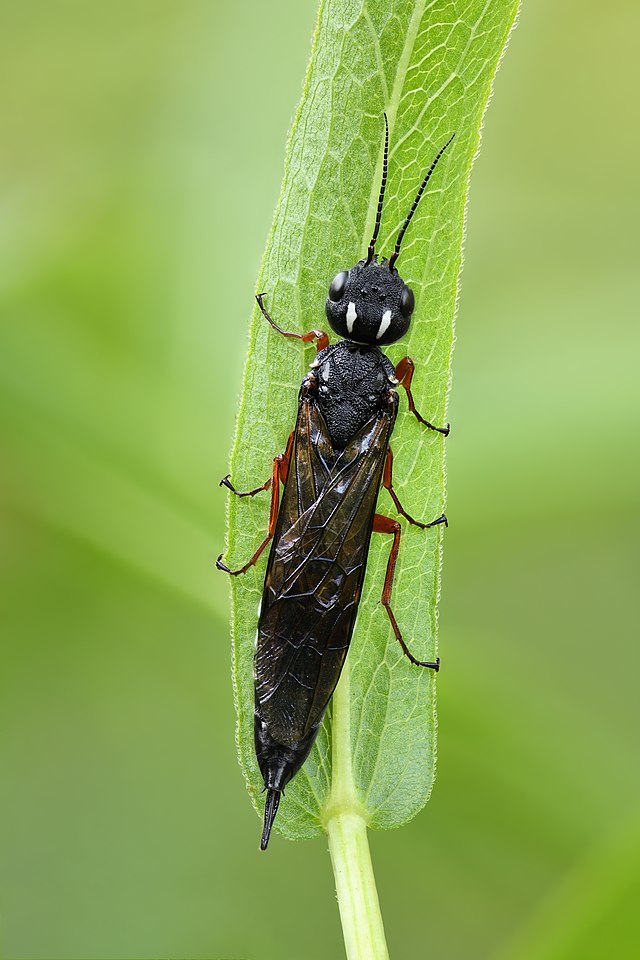Top Qs
Timeline
Chat
Perspective
Xiphydriidae
Family of sawflies From Wikipedia, the free encyclopedia
Remove ads
Xiphydriidae are a family of wood wasps that includes around 150 species. They are located all over the world including North and South America, Australia, Europe, and others.[1] Xiphydriidae larvae are wood borers in dead trees or branches of a range of trees.[2] They are characterized as having long and skinny necks with dome-shaped heads.[3][4] The oldest fossils of the group are from the mid Cretaceous.[5]
Remove ads
Genera
These 29 genera belong to the family Xiphydriidae:[6]
- Alloxiphia Wei, 2002
- Austrocyrta Riek, 1955
- Austroxiphyda Jennings, Macdonald, Schiff & Parslow, 2021
- Brachyxiphus Philippi, 1871
- Calexiphyda Smith, 2008
- Carinoxiphia Wei, 1999
- Derecyrta Smith, 1860
- Eoxiphia Maa, 1949
- Euxiphydria Semenov-Tian-Shanskii & Gussakovskii, 1935
- Genaxiphia Maa, 1949
- Gryponeura Benson, 1954
- Heteroxiphia Saini & Singh, 1987
- Hyperxiphia Maa, 1949
- Indoxiphia Maa, 1949
- Lataxiphyda Smith, 2008
- Lissoxiphyda Smith, 2008
- Megaxiphia Wei, 1999
- Moaxiphia Maa, 1949
- Obesaxiphyda Smith, 2008
- Platyxiphydria Takeuchi, 1938
- Rhysacephala Benson, 1954
- Steirocephala Benson, 1954
- Trixiphidia Wei, 1999
- Xiphidiaphora Benson, 1954
- Xiphydria Latreille, 1802
- Xiphydriola Semenov-Tian-Shanskii, 1921
- Yangixiphia Wei, 2002
- † Paraxiphydria Gao et al., 2022 Burmese amber, Myanmar Cretaceous Albian-Cenomanian
Remove ads
Anatomy and morphology

Head
Most of the species of Xiphydriidae have antennae that are filiform.[3] The antennal segments vary in number ranging from 14 to 22.[3] The maxillary and labial palpi shape and length varies by species. They have an occipital carina which is a ridge in the back of the head.[3] The head is somewhat spherical and is shiny.[7]
Thorax
The pronotum is medially constricted in Xiphydriidae.[7] The defined axillae completely separates the scutum laterally from the mesoscutellum.[8] Parts of the thorax for Xiphydriidae are generally smooth and shiny.[3]
Abdomen
The segment of the abdomen called the gaster can have an orange, red, or yellow coloring pattern.[8]
A study by David R. Smith broke the Xiphydriidae into different groups by their abdomen. The groups were as follows:
Remove ads
Life cycle and development
Larva
The Xiphydriidae larvae phytophagous, meaning bore into dead or weak trees and plants.[8] When they are buried in these trees, they rely on symbiotic fungi for food in the tunnels that they made.[1] The larva either do not have legs or they have vestigial legs. During the larval stage, the head of Xiphydriidae is as long as broad.[9] As a larva, the antenna contains either three or four segments. The first segment of the antenna does not have setae and is not enlarged.[9]
Adult
Adults are 6-21mm long. Adult Xiphydriidae are most commonly found in shadowy places and run on the surface of leaves.[10] The adults have heads that are spherical which are attached to long and skinny necks.[3]
Ecology
Xiphydriidae bore and feed into dying or weakened trees so they do not have a negative effect to the environment.[11] They can be a secondary pest to humans because of the dead wood people may bring into their homes.[9] Xiphydriidae can be a host for parasitoid Aulacidae and they emerge from larvae that are fully grown.[12]
In Japan, female Xiphydriidae were dissected and fungal spores were found.[13] The spores were 5 to 30 micrometers in diameter and had a globular shape. Mucus was also in the glandular organs of some of the wood wasps.[13]
Remove ads
References
Wikiwand - on
Seamless Wikipedia browsing. On steroids.
Remove ads


